|
|
リーフレットあり(¥500)contactページへ
| 風の軌跡Ⅰ |
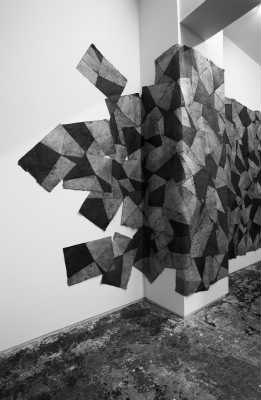 |
時を割る紙
山崎均
雨や水に晒した紙は少しずつ透きとおって映像的なものとなり、光と風景を映し出す。水面のように。紙は水を受け入れる代わりにその強さと構造、物質性を失う。しかし、やがては水を失い、時を凍らすようにして、その水浴の痕跡だけがごわごわした手触りと確かさへ転写されていく。とりわけ手漉き紙は、水との出会いの出来事をみえない記憶のように磁場のように絶えず身につけ反芻しているように思える。
風のように目にみえず、流動的だがかえってその捉えどころなさは徹底した、その強靭さをまるごと、紙に刻まれた「水のアーキテクチャー」と呼ぶとするならば、藤原志保の作品にはこのみえない水のアーキテクチャーの力との思い切った芸術的な対話が地層のように重ねられてきている、といってよいだろう。水は墨と紙と交わり、そこに創造の場のほとんどが賭けられている。こうして作品は、水のざわめく粒子性、強靭な流動性との折り合いをつける、とても特別な場所として見出されるほかない。作者は、どう紙を折りそれをコラージュするかなど、最小限の手しかそこに加えないにもかかわらず、墨の諧調、折った紙の稜線による突出した幾何学が、枯れ葉が水を失い路に転がるような刹那性として、作品のなかのそこかしこに倍音として仕掛けられて強く響き渡るのである。
作品はこの意味で、墨と水と紙との干渉の経験から、ある何か特別なかたちをひきだそうとするものであろう。それを時のかたちといってもよい。墨の粒子は手漉き紙にこもった水の移動や軌跡を露にするメディア(媒)となり、何一つ隠すもののない時の移ろうさまが作品に表れる。あたかも植物の葉についた露を運び去るように風が纏いつき、縹渺としたリミナルな束の間の時間性がそこに現れる、といってよいだろう。紙を折り、墨水に浸し、風に晒す。このミニマルな営み、水というアーキテクチャーとの芸術的な交信記録が折りの紙による巻物風に展開される。それは松籟を待つような空間と関わる出来事が兆す。身の奥底から遊ぶ、アートであり、デザインであり、何者かである。水を棲にする芸術の旅支度のさまを見ているような気がする。作品は時の折り紙、あたかも時を割るような紙の仕事として、独創的である。
(美術館学、神戸芸術工科大学教授)
The Paper that Splits Time Itself
Paper, when exposed to rain and other water, gradually becomes transparent;
reminiscent of a moving picture, it reflects light and scenery. It is as
the surface of water.
As paper takes on water, it loses strength, structure and materiality.
Subsequently, however, it loses that moisture and, in a glacial transformation,
takes on a rough texture and solidity that reveal only the scars from where
water once resided.
Handmade paper, in particular, makes its meeting with water look like it
is grasping for a fleeting memory just out of reach, constantly pulling
at the fluid like a magnetic field and ruminating over it.
This “architecture of water,” as it were—invisible like the wind, fluid
but all the stronger and more resolute for its intangibility as it is etched
into the paper—is a defining feature of Shiho Fujiwara’s works. They are
steeped in the bold dialogue between the artist and the invisible strength
of the architecture of water like so many layers of earth. The water infuses
the paper and sumi ink, and so is the greater part of the platform for
Fujiwara’s unbridled creativity established.
In this way, this piece acts as a truly special place that fuses the “grain”
of restless water and its resilient fluidity.
Fujiwara exerts only the bare minimum of physical influence on a piece,
e.g., deciding on how to fold the paper and the composition of the collage.
Despite this, the gradation of the sumi ink and the stark geometry caused
by the ridges of the folded paper seem to create an ephemeral atmosphere,
like a dead leaf, devoid of its moisture, tumbling to the ground—an ephemeron
in an artwork designed to cause it to roar and resonate in places.
In that sense, Fujiwara’s works urge us to seek special shapes out of the
interaction of sumi ink and water—surely the shape of time itself. The
sumi ink grain is the medium that illustrates and tracks the movement of
the water absorbed into the handmade paper; it makes art out of the passing
of time where nothing is hidden. It is a piece that evokes a temporality,
a cavernous and liminal but fleeting temporality like wind snaking its
way through foliage and whisking dew off a leaf. Paper is folded; it is
dipped in liquid sumi ink and exposed to wind. This minimal process, this
record of the artistic communion with the architecture of water results
in a dramatic depiction in a scroll-like form. It speaks of interaction
with space in which one waits, waits, waits for the wind to course through
the tops of pines.
This is art, design—something—borne of a playfulness that comes from the
deepest reaches of the heart. It makes the viewer feel like he is witnessing
art that resides in water as it prepares for travel. This piece is a creative
example of paper “folding” time—“splitting” time itself.
Hitoshi Yamazaki
Professor of Kobe Design University |
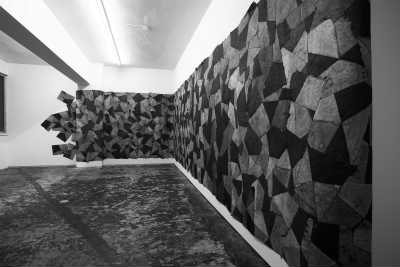
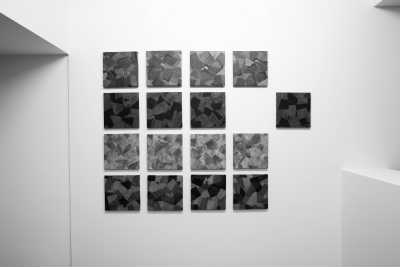
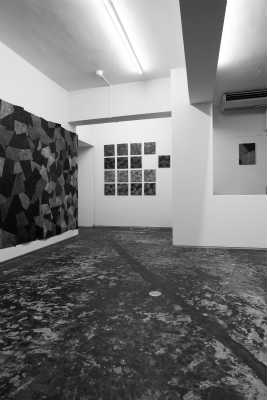
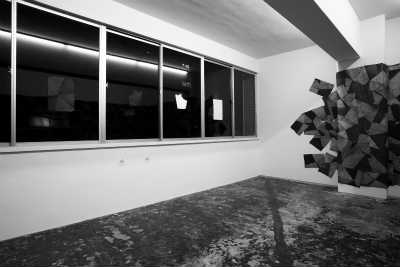
|
|
|
|